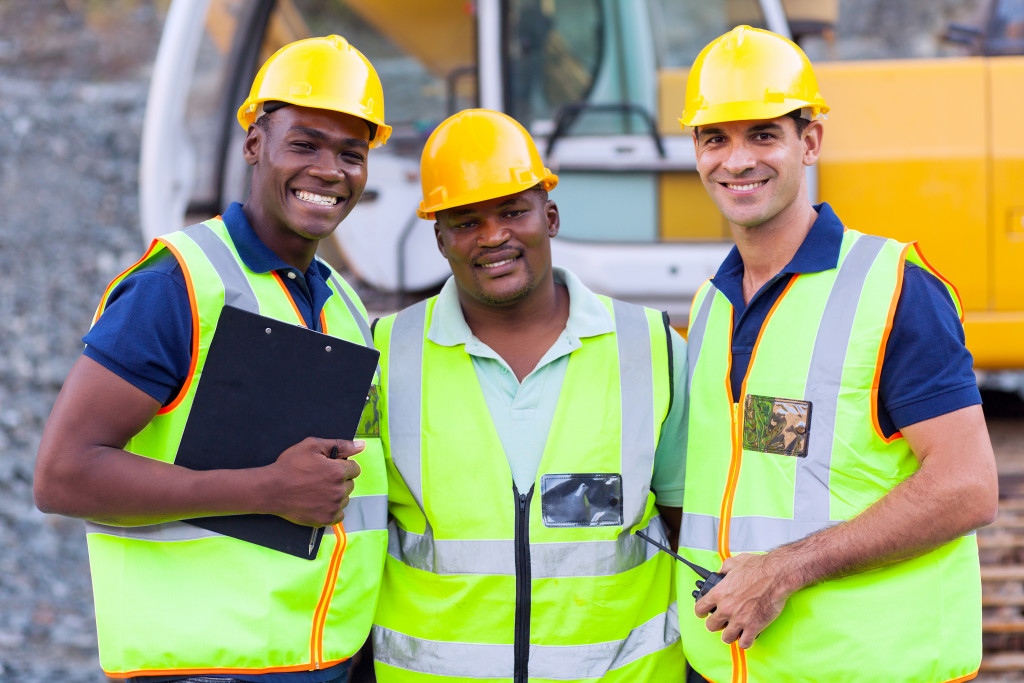- Construction sites are high-risk environments that require stringent safety measures.
- Personal Protective Equipment (PPE) is essential for worker protection and includes hard hats, goggles, gloves, and high-visibility clothing.
- Communication devices like two-way radios are necessary for swift communication on noisy construction sites.
- Fall protection equipment, such as harnesses and guardrails, is crucial to prevent injuries from falls.
- Handling and storage solutions, like wire rope and rigging equipment, help manage heavy materials to prevent accidents.
Construction sites buzz with activity, involving heavy machinery, elevated work areas, and the constant movement of materials, all of which contribute to a high-risk environment. While these elements are necessary for productivity, they also necessitate stringent safety measures.
Ensuring worker safety goes beyond protocols; it requires the right tools and equipment. This article delves into the essential gear and systems that serve as the frontline defense against common hazards in construction sites.
Fundamental Safety Gear for Construction Workers
The first step in minimizing risk on construction sites is equipping workers with personal safety gear designed to offer protection and ease of movement during their tasks.
Personal Protective Equipment (PPE)
The construction industry cannot function safely without standard Personal Protective Equipment. Hard hats are mandatory to protect against falling objects, while safety goggles shield eyes from flying particles or hazardous liquids.
Gloves with the right grip and protection are essential for handling materials, and steel-toed boots can prevent foot injuries from heavy, falling objects. High-visibility clothing ensures workers are easily noticeable in busy or low-light areas. Each piece of PPE is a critical item in the daily life of a construction worker, serving as an immediate barrier against accidents.
Communication Devices
On a noisy construction site, the ability to communicate swiftly and clearly can’t be underestimated. Devices like two-way radios ensure workers can alert others of danger, coordinate activities to prevent mishaps and call for immediate help if an accident occurs. In areas where noise levels might drown out verbal warnings, other alert systems like sirens or visual signals are crucial additions.
Essential Safety Equipment on Site

Beyond personal gear, the site itself must be equipped with specific safety equipment to protect workers from common hazards associated with construction tasks.
Fall Protection Equipment
Working at height remains one of the leading causes of injuries on construction sites. Comprehensive fall protection equipment, including harnesses, safety nets, and guardrails, is vital.
These systems prevent falls or provide a safeguard if a worker slips or trips. Especially during skyscraper construction or infrastructure repair, these tools provide workers with the confidence to move and work freely, knowing they are secure.
Proper Handling and Storage Solutions
Construction sites are rife with heavy materials and machinery. Wire rope and rigging equipment are integral to managing these loads, ensuring they can be lifted, moved, and positioned without endangering workers. Additionally, secure storage solutions prevent materials from unintentionally shifting or falling, contributing to a safer, more organized work environment.
Implementing Safety Protocols and Training
While having the right tools and equipment is a critical step, it’s equally important to ensure that workers know how to use them properly and understand the safety protocols. Regular training, drills, and maintenance routines foster this knowledge and understanding.
Regular Safety Drills and Education
Safety in a construction environment is an ongoing learning process. Regular safety drills should be conducted to keep workers familiar with what to do in case of emergencies, such as fires, electrical failures, or structural collapses.
These drills and educational sessions about potential work-site hazards and safe equipment operation help reinforce safety protocols. This continual education ensures that all workers are up to date, reducing the likelihood of accidents caused by human error.
Inspection and Maintenance Routines

Even the best safety equipment can fail without regular inspection and maintenance. It’s vital to establish routines for checking all safety gear and machinery. For instance, harnesses and ropes used for heights must be inspected for wear and tear or any damage, ensuring they are safe for use.
The same goes for machinery, tools, and especially wire rope and rigging equipment, which must be regularly checked to prevent malfunctions that could lead to accidents.
The Bottomline
The safety of construction workers is an aspect that should never be compromised. By investing in high-quality safety gear, ensuring proper and safe equipment handling, and enforcing regular safety education and equipment maintenance, construction sites can become safer places for all workers.
It’s about creating an environment where safety is part of the culture, and everyone knows their role in maintaining it. This approach helps protect the workforce and contributes significantly to the efficiency and success of construction projects.

